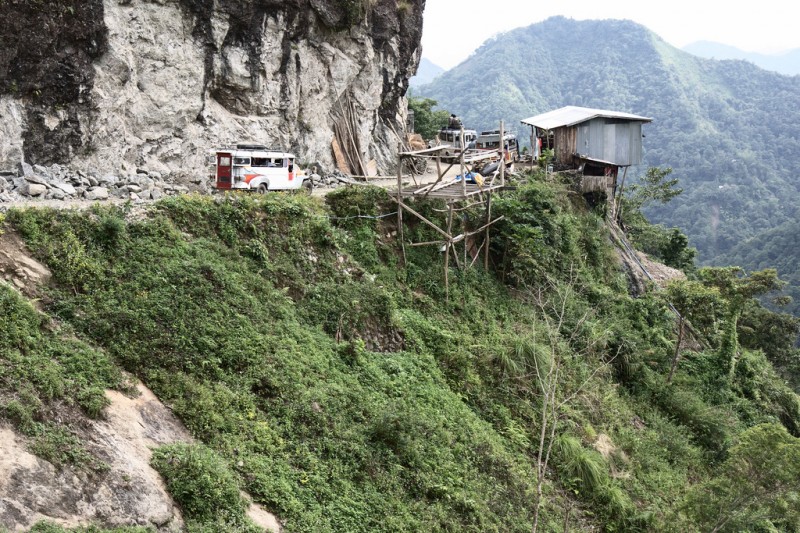ジプニーは、この半世紀の間、フィリピンでは誰もが認める“キング・オブ・ザ・ロード”である。多くの人が使う身近な交通機関であるだけでなく、フィリピン人らしさの象徴になっている。
ジプニーは、元をたどればアメリカの遺物である。第2次世界大戦が終わり、不用になった軍用ジープをアメリカ人が放置した。そのジープがフィリピン人によって公共交通の車両へ転用されたのだ。
When American troops began to leave the Philippines at the end of World War II, hundreds of surplus jeeps were sold or given to local Filipinos. Locals stripped down the jeeps to accommodate several passengers, added metal roofs for shade, and decorated the vehicles with vibrant colors and bright chrome plating and hood ornaments.
第2次世界大戦の末期、アメリカ軍がフィリピンから撤退する際に何百台もの不要なジープを現地フィリピン人へ売ったり与えたりした。多くの客を乗せられるようにフィリピン人はこのジープを改造し、日よけの金属屋根や幌を取り付けたり、鮮やかな色彩、明るいクロムメッキを施したりした。
フィリピン人は、ジプニーに絵を描いたり、さまざまな飾りを付けたりした。
Filipinos also started adding colorful and shiny ornaments, and using the car’s metal body as canvas for painted or airbrushed images of personal significance, or adverts. The Jeepney became a part of Filipino culture, and an inexpensive means of transportation for the country’s proletariat.
さらにフィリピン人は、ジプニーに色とりどりのきらびやかな装飾を施したり、金属の車体を、絵の具やエアブラシで描く自己表現やアピールのキャンバスとして使ったりするようになった。ジプニーはフィリピン文化の一部となり、この国の労働者層にとって安価な交通手段となった。
ジプニーのボンネットによく取り付けられる飾りは、馬をかたどったものだ。
Gilded iron moldings, intricate art work of paintings depicting country side scenery, lapels, tassels and sometimes glittery tinsels abundantly distributed inside and outside. And finally, the wrought iron symbol of a horse drawn carriage and a chrome finished horse, festooned on top of the hood as an ornament and as a reminder of a past glory representing the horse drawn carriage.
ジプニーには、内側も外側も、金箔を施した鋳造品、田園風景を描いた緻密な絵画、襟状の飾りや房飾り、時にはきらきらと輝くティンセルなどのおびただしい装飾品がちりばめられる。そして最後に、昔日の繁栄のメモリアルとして精巧な鉄製馬車とクロム加工された馬が、ボンネットに花綱状に飾りつけられる。
フィリピンの他の島々では、日本のエルフトラックが解体されジプニーとして生まれ変わっている。
In Cebu, popular jeepney manufacturers are Chariot and RDAK, known for its “flat-nosed” jeepneys made from surplus Suzuki minivans and Isuzu Elf trucks, which are no longer in use in Japan. These are equipped with high-powered sound systems, racing themes, and are bigger and taller than those in Manila.
セブ島で有名なジプニーメーカーはChariotとRDAKだ。日本で使われなくなったスズキのミニバンやいすゞのエルフを改造した“フラットノーズ”型ジプニーがよく知られている。 このジプニーには高性能の音響システムが装備され、カーレースのテーマ音楽が流れている。車体はマニラ製より大型で車高も高い。
乗り方を知るのに役立つジプニー入門動画
この国には、公営・民間を問わず、ジプニーを保有して運輸事業を行う大手企業は存在しない。 つまり、ジプニーの運転手はつねに路上で乗客獲得競争をしている。
In the Philippines , jeeps compete with each along the same route. Competition for customers is intense, and thousands of jeeps eke out a living gathering as many customers as possible by running as often as possible.
…so eager are jeeps to gain your patronage, that they will stop anywhere for you as long as you are within sight. This is to the detriment of people in private cars, but to the benefit of the jeepney-riding public.
フィリピンでは、ジープはお互いに同じ路線で競争をしている。乗客獲得競争は激しく、何千台ものジープはできる限り多くの乗客を乗せ、できる限り回転を良くすることで、辛うじで生計を立てている。
・・・ジプニーは常連客を獲得するのに必死なので、客と見ればどこでも停車してくれる。 自家用車に乗っている人々にとっては迷惑だが、ジプニー利用客にとってはありがたい。
フィリピン在住英国人のブログManila Concierge Onlineによると、ジプニーは伝統と進歩の争いを象徴しているという。
They represent a battle between traditional and progress and up to now the traditional is still winning. As much as they have charm, history and being a part of the culture, it could also be said that they are totally unsuitable in almost every imaginable way as a modern public transport vehicle.
ジプニーは伝統と進歩とのたたかいを象徴しているが、今のところはまだ伝統が優っている。 歴史、そして文化の一部としての魅力を兼ね備えてはいるものの、どう考えてもジプニーは現代の公共交通車両として適した乗り物ではない。
しかし、このブログの筆者は、ジプニーの座席は親しい会話を生みやすいつくりであるという点について指摘している。
Although most people simply keep to themselves on a jeepney, I have had many a friendly exchange riding one of these crazy people trucks. The nature of the seating means you are sat facing each other and I’m often smiled at as eye contact and close human interaction is unavoidable which is all part of the charm of the jeepney, a small compensation for the slight discomfort of being on a crowded one.
多くの人は、ただジプニーに乗るだけだが、私は最高にすてきな人たちと一緒に乗って、和気あいあいと話がはずんだ経験が何度もある。 ジプニーに乗れば、おのずと互いに顔を見合わせて座り、アイコンタクトとして微笑みかけられ、否が応でも親密なふれあいをすることになる。そういったことのすべてがジプニーの魅力であり、混んだ車内で少しばかり窮屈な思いをすることへのちょっとした見返りである。
近年、政府は渋滞や大気汚染の解消へ向けて、ジプニーに対するより厳しい規制を行うようになった。電動ジプニーを導入した町もあるほどだ。最新技術によるジプニー車内の無料wifiやCCTV(訳注:監視防犯カメラ)が標準装備になる日もそう遠くないであろう。
ツイッター写真 定員オーバーで屋根まで人を乗せたジプニー
Jeepney here in province be likepic.twitter.com/xSThHDuxP7
— Alyssa Abordo (@HeyMaggiee_) April 13, 2014
田舎のジプニーはこんな感じ…

















